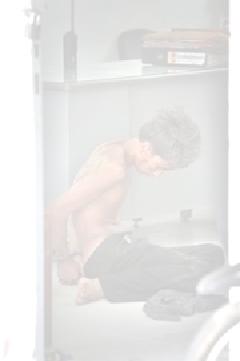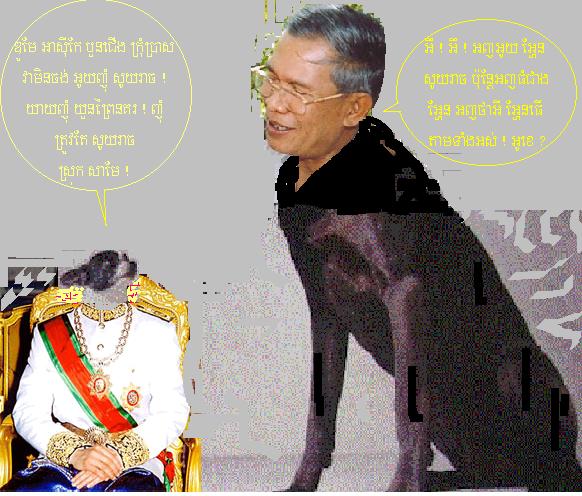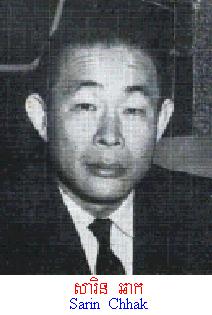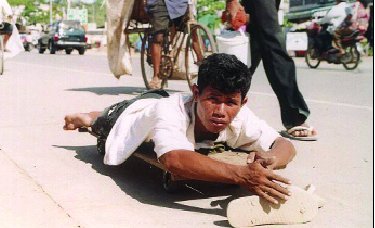RENCONTRER
DIEU |
COURRI@L
2005
|
MEET
WITH GOD |
Playing the Vietnam Card (2005-Jun-22)
The Monitor's View - Just as the US war
in Vietnam was really about containing China's
influence in Asia, so too is Washington's
warm welcome this week for Vietnam's prime minister. China's been making
friends fast in its big neighborhood, and its success so far has the US
and Vietnam rightly worried that Beijing's hefty diplomatic and economic
body-weight might turn into real military muscle in the region.
China once occupied Vietnam for nearly a millennium, and the latest big
offense to its historic adversary to the south was a quick border war in
1979, a nosebleed "lesson" to Vietnam for ousting the pro-Beijing Khmer
Rouge in Cambodia. Vietnam can't get too close
to the US now for fear of another Chinese
lesson, but the visit of Hanoi's prime minister does help solidify ties
that have grown since the two nations opened diplomatic relations in 1995.
The visit of US warships to Vietnam since 2003 has given hope of a future
alliance that will further keep US military dominance in Asia, a role that
most of the region welcomes as necessary for its security and prosperity.
Hanoi still needs to decide how much to welcome a US naval presence at
Cam Ranh Bay and other well-known harbors of the war years.
The US, too, can't get too close to Vietnam
until it moves toward free, multiparty elections and reduces human rights
violations of political dissidents and religious figures. Otherwise, the
Bush doctrine of promoting democracy looks
hollow.
As US-Vietnam trade expands, the two nations will draw together naturally.
Hanoi, despite the war, always knew it would
need the US as a counterweight to other big powers.
That's why, after North Vietnamese troops took over Saigon in 1975, they
didn't rub it in the US nose by hoisting their flag over an empty American
embassy. [ Christian Science Monitor ]
One Child Dead, Others Rescued in Cambodia (2005-Jun-16)
By DANIEL LOVERING, Associated Press
Writer
SIEM REAP, Cambodia - Masked gunmen seized dozens of children
at an international school Thursday in northwestern Cambodia, killing a
3-year-old Canadian boy and vowing to shoot the others one by one before
police rescued the hostages, authorities said. The attackers stormed Siem
Reap International School, grabbed students from several countries,
and demanded money, weapons and a vehicle before police ended the six-hour
standoff and took four young gunmen into custody.

|

|
The attackers shot the boy when authorities refused to meet all of their
demands, then "threatened to kill the other children one by one,"
said Information Minister Khieu Kanharith. Authorities said they managed
to talk the attackers out of the building after giving them a minivan and
$30,000 in cash. When the men got into the vehicle with four children,
security forces closed the gate to the school compound and launched an
assault, yanking the men from the van. Nearly 40 children, some as young
as 2, rushed past the school gate and into the arms of their panic-stricken
parents. "I'm very relieved," said Tan Seok Ho of Singapore, who
rushed to the school when she heard about the crisis from a friend. Her
youngest child Levon was among those taken and released unharmed. "I'm
happy to have him back in my arms again."
Some parents, meanwhile, grabbed three of the hostage-takers from police
and began beating and kicking them, said Prak Chanthoeun, the military
commander. "We could barely control the angry crowd," he said. The
crisis unfolded at Cambodia's tourism hub of Siem Reap, near its historic
Angkor temples -- one of the world's most famous archaeological sites.
The town is home to many expatriates, and the school killing quickly drew
concern from governments around the region. Children from
at least 15 nations -- including the United States -- attend
the school. Hundreds of people gathered outside the yellow schoolhouse
during the tense standoff, and three armored personnel carriers were parked
on the road.
The identity of the attackers was unclear, even after the standoff ended.
Prime Minister Hun Sen said they appeared to be security guards at the
school, but police later said teachers did not recognize them. The men
originally took about 70 people but later released 30 of them, Khieu Kanharith
said. They "were armed with shotguns" and demanded money, six AK-47 assault
rifles, six shotguns, grenade launchers, hand grenades and a car, said
Deputy Military Police Commander Prak Chanthoeum, who said three teachers
were among those seized. Denis Richer, a Frenchman who teaches at another
school in Siem Reap, said he tried to comfort the father of the young boy
who died. "He was completely lost. He asked me
to look for his wife, which I did. I found an ambulance to bring the couple
to the clinic."

|

|
Police initially said there were six attackers, but later put the number
at four. They said the hostage takers were 22 to 25 years old, and were
from the southeastern province of Kandal. Witnesses said one of the attackers
lay wounded on the ground after the siege had ended. The children, most
of them aged 2 to 6, come from a variety of countries, including the United
States, Italy, Japan, Britain and Australia. Khieu Kanharith described
the boy who was shot as a 3-year-old Canadian. Embassy officials could
not immediately confirm that, but a witness who knew the child also identified
him as Canadian. [ Photos Reuters ]

1143 victimes d'accidents de circulation en avril (2005-Jun-11)
Koh Santepheap : Selon l'organisation Handicap International
les accidents de circulation dans l'ensemble du Cambodge au mois d'avril
dernier (mois de la fête du Nouvel An khmer) ont fait 1143
victimes, une nette augmentation pa rapport au mois de mars
(832 victimes). A Phnom Penh, plus de 400 accidents ont causé
la mort de 16 personnes, un accroissement de 9% par rapport à
la même période, l'an dernier. La province de Kampong Cham
fut celle qui a connu la plus grande augmentation du nombre d'accidents
de circulation pendant ce mois.

Par ailleurs, les mines et autres explosifs
ont fait de leur côté 80 victimes au même mois
d'avril.
|
|

PHOTO
: Dans la ville de Siemreap, un estropié
se déplace sur une planche à roues et fait appel à
la générosité des gens pour faire vivre sa famille.
Sann Ohn, 38 ans et sa femme So Voeun, 37 ans, ont travaillé
tous les deux comme ouvriers de construction à Phnom Penh. Il y
a trois ans, une voiture l'a heurté quand il traversait la rue au
chantier avec un sac de ciment sur le dos. Un os de sa jambe gauche fut
brisé, et sa jambe droite a dû être amputée.
Sa femme travaillante nourrissait alors la famille - lui et leurs deux
petits garçons. Maintenant que sa compagne, souffrant de tuberculose
avancée, ne peut plus travailler, c'est à son tour de nourrir
la famille ... en mendiant.
(2005-Jun-06)
Le
Roi
Règne,
Le
Premier
Ministre
Gouverne
|

|
Sarin Chhak (2005-Jun-04)
Border expert's fate a mystery
By Julio A. Jeldres : The current debate over Cambodia's borders
has involved references on several occasions to the name of Sarin Chhak,
the eminent author of the only complete study (in four volumes) of the
Kingdom's borders, whose whereabouts have been the source of much speculation
following his disappearance immediately after the Vietnamese invasion of
Cambodia in January 1979. Sarin Chhak was born Khin Kaing, in Krangsla
village, Prey Kabass district, Takeo province on January 2, 1922. He was
the child of Mr. Khin and Mrs. Chhay Lak, both farmers. Because he had
to help his parents on the farm, he was unable to attend primary school
at an early age like other Cambodian children. During the French colonial
period, a regulation forbade children of advanced age to enroll in primary
school, so in order to attend, Kaing changed his name to Sarin Chhak because
he did not want to disclose his real age. He was a good student and was,
therefore, encouraged to pursue studies at a higher level. He graduated
from Phnom Penh University with a law degree and obtained his Ph.D.
in Economic Law in France in 1966. The topic of his dissertation
was "The Borders of Cambodia".
Paul Reuter, a professor at the Faculty of Law of the University of Paris
and one of Cambodia's lawyers in the Preah Vihear case, writes in the introduction
to the first volume of "Borders of Cambodia" that "[Sarin Chhak's] work,
brilliantly presented in front of the Faculty of Law and Economic Sciences
of Paris, will permit the author to find an attentive audience, which shall
not fail to appreciate the conscience, the tireless labor and the merits
of the author." Adding that, "Sarin Chhak
abstained from creating any polemic or of using words filled with bitterness
and inviting us to believe that violence is not the only recourse to achieve
an aim." Upon his return to Cambodia, he joined the Ministry
of Foreign Affairs and served in different posts within the ministry and
also at the Cambodian Embassy in Paris. He was appointed Ambassador to
the United Arab Republic (Egypt) in 1968, with residence in Cairo, while
concurrently serving as Ambassador to Senegal.
 |
|
Following the coup of March 18, 1970, Sarin Chhak denounced the
coup, refused to recognize the Lon Nol government and declared his allegiance
to Samdech Norodom Sihanouk as the legal Head of State of Cambodia. At
the same time, he announced that the Cambodian Embassy in Cairo had become
the "Embassy of Progressive Cambodia in the UAR". He was made a
member of the Political Bureau and Central Committee of the National United
Front of Kampuchea (FUNK), following
its establishment in Peking in March 1970, and he was appointed Minister
of Foreign Affairs of the Royal Government of National Union of Kampuchea
(GRUNK) in May 1970. As such he traveled widely in Africa, where he had
many friends and acquaintances urging the early recognition of GRUNK by
several African countries. However, upon the arrival in Peking of Ieng
Sary, the so-called "Special Envoy from the FUNK-GRUNK
within Cambodia," things began to work against the royalist elements
of the Front - including Sarin Chhak, Chea San, Huot Sambath and others
- and in favor of the Khmer Rouge, whose representative in the Chinese
capital was Ieng Sary. Sary had been tasked with changing the composition
of FUNK and GRUNK and making them more in tune with Khmer Rouge policies
and strategies. Until Sary's arrival in Peking, the Khmer Rouge had little
influence on the Front's policies and activities, which were directed from
the Chinese capital by Samdech Norodom Sihanouk, Chairman of FUNK and Head
of State, and Samdech Penn Nouth, Chairman of the Political Bureau of FUNK
and Prime Minister of GRUNK. According to former members of FUNK and GRUNK
who escaped the Khmer Rouge's gulags by exiling themselves to France, or
who survived them, Sarin Chhak was highly appreciated by Sihanouk and former
Cambodian Prime Minister and GRUNK's then-Prime Minister (1970-75) Penn
Nouth but detested by Ieng Sary. |
Penn Nouth managed to get Sarin Chhak appointed Deputy Prime Minister of
GRUNK, concurrent with his maintenance of the Foreign Affairs portfolio,
just before the fall of Phnom Penh and this enraged Ieng Sary even further
(1). After a mission to the United Nations in October 1975, during which
he met with US Assistant Secretary of State Philip Habib, Sarin Chhak disappeared
from the scene and later reappeared in the notorious
Beoung Trabek concentration camp for diplomats run by the Khmer Rouge.
Several people have said that after Vietnam's invasion of Cambodia in 1979,
he was taken by Vietnamese soldiers to a Vietnamese military vehicle
and driven to an unknown destination (2). Some of my sources, including
the children of Sarin Chhak currently living in France, have suggested
that the Vietnamese took Sarin Chhak and his wife to Hanoi, where they
kept him under house arrest until his death in the early to mid-1990s (3).
According to the same sources, during a visit to Hanoi by Sihanouk in July
1970, the Vietnamese hero General Vo Nguyen Giap asked one of his staff
to point Sarin Chhak out to him. The same sources suggest that it was not
in Vietnam's interests to leave Sarin Chhak free, particularly outside
Cambodia, as his thesis had stated that portions of Cambodia's territories
had been given to Vietnam, particularly in the south of the country. This
had not been forgotten by the Vietnamese.
In late 1979 former GRUNK Finance Minister Thiounn Mumm asked Ieng Sary
to launch a campaign to find Sarin Chhak, but Mumm says Sary refused, arguing
that once liberated he could turn against "Democratic Kampuchea" (4). In
1989, during the first Paris International Conference
on Cambodia, the surviving children and grandchildren of Sarin Chhak
wrote to Sihanouk and asked him to intervene for the release of their parents.
Samdech Sihanouk wrote immediately to Mr. Hun Sen, but to the best of
my knowledge, there was no answer from the latter (5). Then in September
1991 the family again wrote to Sihanouk advising that they had received
reliable information, according to which Sarin Chhak and his wife had been
kept until April 1991 in Vung Tau (also known as Cap Saint Jacques), a
seaside resort about two hours drive from Ho Chi Minh City, and then taken
back to Hanoi (6). Samdech Sihanouk wrote to Vietnamese Prime Minister
Vo Van Kiet and to Hun Sen again. The Vietnamese leader replied that after
a serious investigation, it had been found out that
Ambassador Sarin Chhak and his wife were not in Vietnam (7). So,
what happened to Sarin Chhak and his wife? It is a mystery. Was
he taken to Vietnam and kept under house arrest until his death? Or was
he killed by the Khmer Rouge? Let us hope that the forthcoming Extraordinary
Chambers to judge the Khmer Rouge may bring to light some information
on what happened to Sarin Chhak and his wife and allow their children and
grandchildren to resume normal lives.
_____________________
(1) Author's interviews with the former GRUNK Ambassador to Algeria,
the late Mr. Chem Snguon; GRUNK Minister of Armaments, General Duong Sam
Ol and GRUNK Finance Minister Mr. Thiounn Mumm in Paris 1989 and 1995 respectively.
(2) Author's correspondence with the former GRUNK Ambassador to
North Korea, the late Mr. Ang Kim Khoan, and interview with General Duong
Sam Ol in Paris in 1995.
(3) Author's correspondence, 1997-2000, with Sarin Chhak's eldest
daughter Madame Chhary Khin.
(4) Mr. Thiounn Mumm's letter to the author dated January 23, 1997.
(5) Letter from Samdech Norodom Sihanouk to Mr. Hun Sen, Paris,
August 1, 1989, copy in my possession.
(6) Letter from Madame Khin Chhary to Samdech Sihanouk, Paris, September
11, 1991, copy in my possession.
(7) Letter of Samdech Norodom Sihanouk, Paris, September 14, 1991,
and response from Vietnamese PM dated October 9, 1991, copies in my possession.
Phnom Penh
Post, Issue 14/11, June 3 - 16, 2005 © Michael Hayes, 2005.
All rights
revert to authors and artists on publication.
GOD
vs BUDDHA
|
camboDIATRIBE
|
COURRI@L
2005
( PREVIOUS )
|
AUTRES
SITES KHMERS
|
KUN
PIMOJ 's HOMEPAGE
|
PHN@M-P@NH-P@TINS
|
FRAN-GLO-GIBWÉ
|
CANADA
3 FOUNDERS
|
MES
EMAILS 2003
|
THE
6 COMMANDMENTS
|
MEET
WITH GOD
|
PEN Nearovi, Montréal, Québec, Canada
(nearovi@sympatico.ca)






![]()

![]()

